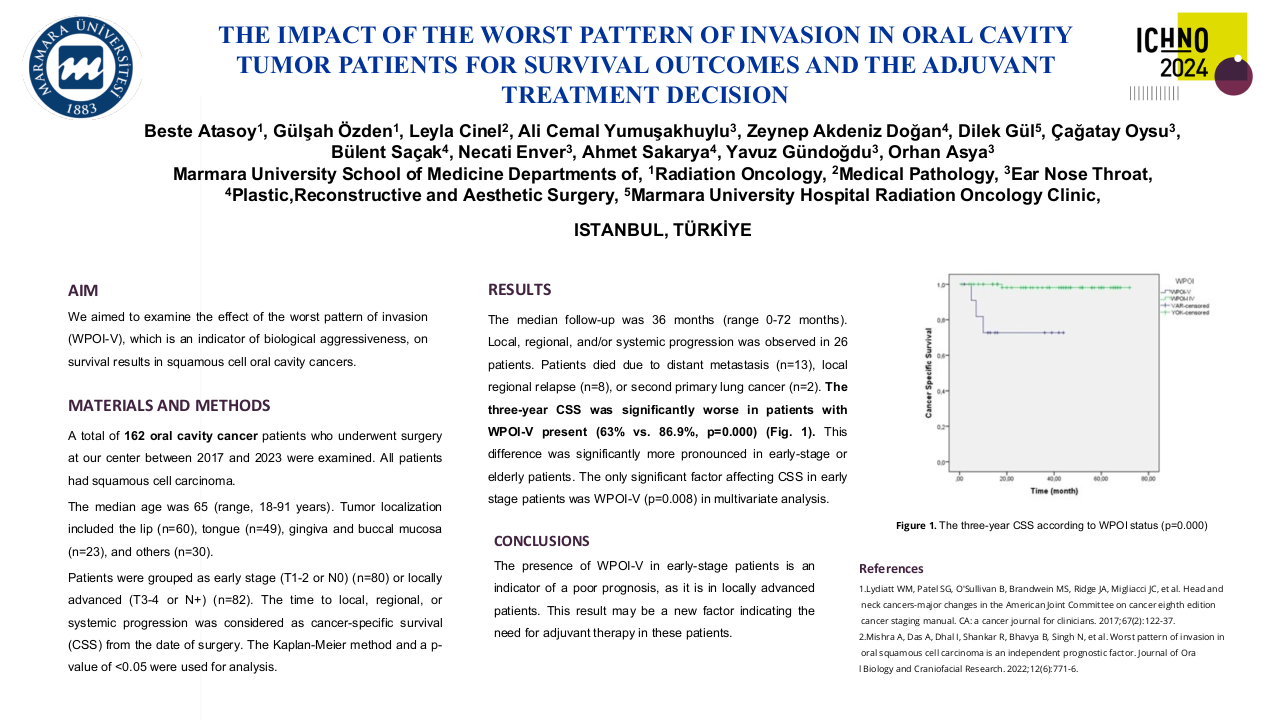Radiotherapy as a therapeutic weapon in the adjuvance of nasosinusal adenocarcinoma intestinal-type
Purpose/Objective
Intestinal-type adenocarcinoma (ITA) is the second most common nasosinusal adenocarcinoma. It occurs mainly in men and has a high incidence in workers exposed to wood dust. If resectable at diagnosis, surgical excision of the lesion plays a decisive role, with radiotherapy (RT) being a very important therapeutic weapon in these lesions, either as an adjuvant treatment or as a radical treatment in inoperable tumors. The objective of this study was to analyze demographic data, clinical presentation, risk factors, the applicability and treatment of radiotherapy and the survival of patients with nasosinusal adenocarcinoma of the intestinal type.
Material/Methods
Retrospective study of patients with nasosinusal adenocarcinoma intestinal-type treated between 2013 and 2022, at the Radiotherapy Service of Centro Hospitalar Universitário de São João. Statistical analysis was performed using IBM SPSS Statistics version 29. Survival analysis was performed using the Kaplan-Meier method and comparisons using the Log-Rank test. Considered a significance level of 0.05.
Results
Nineteen patients were identified, all male. One locksmith and 18 carpenter patients. The average age at diagnosis was 58.7 years and the average follow-up time was 22.9 months. Nasal obstruction with rhinorrhea (73.7%), orbital complaints (13.2%) and epistaxis (13.2%) were the symptoms presented at diagnosis. At diagnosis, 10 patients were T4, 4 patients T3, 2 patients T2 and 2 patients T; 17 N0M0 patients and 2 NxMx patients. In the pathological anatomy of surgical resection, 14 patients had Rx margins, 2 with R0 margins, 2 patients with R1 margins and 1 patient with R2 margin. The most common therapy was surgery with adjuvant radiotherapy. The total dose range used in RT was 56-70Gy with conventional fractionation, 1x/day, 5 days/week, with 2 patients undergoing the 3D-CRT technique and the remaining 17 with VMAT. The most serious toxicity described was G2 enanthema (1 patient), with 5 patients without toxicities. Overall and disease-free survival were 68.4% and 57.9%. Six patients died, 2 due to non-oncological disease, 5 are alive with disease progression, 4 alive with stable disease and 4 with no evidence of recurrence. Distant metastasis was 26.4%. Intracranial invasion influenced both local disease-free survival (p=0.001) and global disease-free survival (p=0.005). Venous invasion had an impact on distant metastasis-free survival (p=0.01).
Conclusion
Sinonasal adenocarcinomas are heterogeneous tumors, essentially with local recurrence and a poor functional and vital prognosis. Multidisciplinary evaluation of these patients is mandatory, as radiotherapy plays an important role in the treatment of sinonasal cancer, especially in an adjuvant setting after surgical resection. Our retrospective study demonstrated that R0 resectability is often difficult to ensure and therefore adjuvant treatment is important. The total dose regimen of 60 Gy in 30 fractions is the most commonly used. In our sample, imaging-proven intracranial invasion and histological venous invasion are associated with a worse prognosis.






